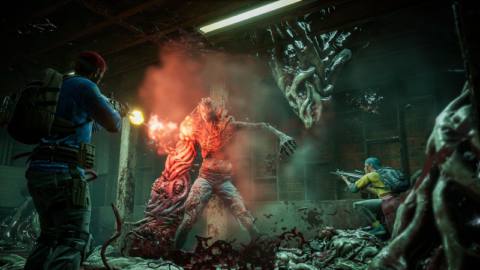
Founded in 2002, Turtle Rock Studios got its start working on the Counter-Strike and Half-Life series alongside Valve. However, the studio truly made its name through its first all-original game, a cooperative zombie shooter called Left 4 Dead. Valve was so impressed by the project that it acquired Turtle Rock in 2008 and released the game later that year. Left 4 Dead was a smash hit for the developer, and both paved the way for the co-op shooting genre and contributed to a zombie explosion in gaming.
Following the studio’s split from Valve in 2009 (where Valve retained the Left 4 Dead IP), Turtle Rock began work on what would eventually become the asymmetric multiplayer shooter Evolve. Valve put out a second Left 4 Dead developed in-house, and countless other studios replicated the formula to varying results. Still, few captured the magic of that first Left 4 Dead. Now, the studio that popularized the genre is back with a new effort that not only carries on the tradition of its most popular game but expands the formula in new directions.

Rising from the Dead
In the post-Valve era of Turtle Rock Studios, the team began conceptualizing asymmetric multiplayer modes where a group of players hunts down a single powerful character. That idea eventually turned into Evolve, where a group of four hunters tracks a monster through an environment, and the monster evades the hunters until it becomes powerful enough to take them on. Evolve impressed at expos and in trailers, but longer play sessions revealed cracks in the formula. When it launched in 2015, it did so to tepid critical reception and fastly-dwindling player bases.
“In hindsight, when Evolve was playing correctly and when it was on, it was really, really great,” says studio co-founder and Back 4 Blood creative director Phil Robb. “But the problem was that it fell apart pretty easily whenever you had a teammate that wasn’t up to the task of fulfilling their role.”
The servers for Evolve shut down in 2018, leaving Turtle Rock fans to ponder the future. Thankfully, they didn’t have to wait long, as mere months after the closure of Evolve, in March 2019, the studio announced Back 4 Blood.
“We had some potential projects that we worked on here and there that never saw the light of day, which sort of happens a lot more than you’d like when you’re an independent developer,” Robb says. “We actually worked on a lot of cool s— during that time that we didn’t really ever get to show anybody, but at some point, somebody threw the opportunity out there and said, ‘Hey, how would you guys feel about getting back into the zombie space?’ Of course, we’re like, ‘Hell yeah!’ We love that genre, we like working in that space, and I feel like we’d been away from it long enough that we were anxious to get back in and start banging on that again.”
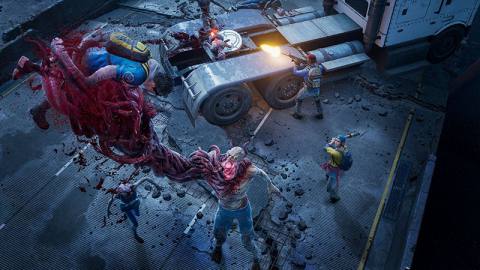
Clearly drawing inspiration from the Left 4 Dead name, Back 4 Blood has been considered by many a spiritual successor of the studio’s defining hit. Robb also recognizes it’s a bold choice but says the developer was setting itself up since it knew people would make comparisons regardless. But as he tells it, there’s more to Back 4 Blood’s name than just an homage to the studio’s previous games.
“There’s some other sort of poetic stuff in there if you think about it,” Robb says. “We had a bit of a rough time with our previous project, so we sort of felt like we’re back for blood. We were happy to be back in a genre and territory we loved being in back then and feel pretty comfortable in.”
The basic premise of Back 4 Blood remains true to what Left 4 Dead fans remember: You join up with a team of survivors (called Cleaners) to venture through an area infested with zombies (called Ridden) scrounging supplies and killing anything in your path. Along the way, you encounter objectives, special enemy types, and, of course, hordes upon hordes of zombies. That foundation will sound familiar to anyone who played Left 4 Dead, but the studio wasn’t content with simply replicating past successes. Instead, the team re-examined every part of the formula to home in on what made the original special.
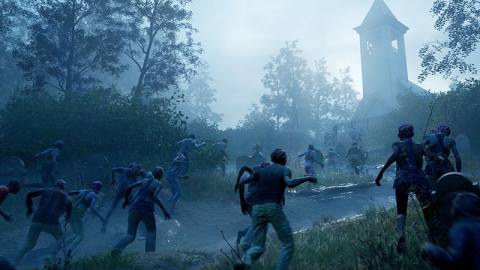
Along this path, Turtle Rock implemented a new cards system to help each run play out differently. While each Cleaner has some minor advantages built in (Holly grants additional stamina to the team while Evangelo gives everyone a slight speed boost), the deeper modifiers come from these cards. Before entering a session, you assemble a deck from your collection to bring with you. Then when you enter your game, you draw cards and apply different modifiers for that playthrough.
Card systems like this have appeared in several games, but Turtle Rock didn’t want to shoehorn the mechanic in if it wasn’t the right fit. “I was even skeptical of it a little bit at first, but it’s totally grown on me,” Robb says. “I think at the end of the day when you play Left 4 Dead, you had a certain degree of agency in that you know you could go where you wanted, there was a number of weapons you could choose from, and then it was kind of just skill, and that was about it. With this, we introduced a lot more player agency, which I think is a welcome addition to the genre.”
These cards do things like provide extra health or damage, improve your reload speed, or give you an extra life in the session. Some even affect the entire squad, like one I equipped that increased ammo capacity for my whole team. I was initially uncertain of this system, but as I played multiple runs of the same mission, I enjoyed the random elements that help keep the experience fresh. In addition, since you can build your deck, it’s easier to complement your desired playstyle through cards meant for support, damage-dealing, scavenging, and more.
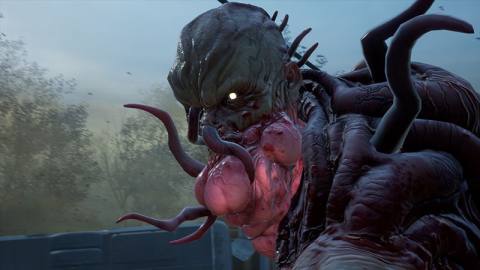
Running For Our Lives
After a quick stop in Fort Hope (see sidebar) to gather my co-op partners, we jump into the opening campaign, The Devil’s Return. This action-packed string of missions tasks us with blasting our way through an industrial park, crossing an overrun bridge, and blowing up a cruise ship, but first, we need to choose our cards, including a corruption card, which adds a modifier or bonus objective to the entire match. Since this is our first match in Back 4 Blood, I keep it simple, making it so if we get to the saferoom without any of us dying, we get extra copper, the in-match upgrade currency.
You start each session with a meager amount of copper, allowing you to upgrade your starting loadout in the initial saferoom. I decide to save my copper for next time, opting for the free automatic rifle sitting on the chair. Once we’re all geared up, we unlatch the lock and begin bashing and blasting.
The early goings of this stage take place in a dilapidated apartment complex. While the sorry state of the building is terrible news for those without renter’s insurance, the loot found in the rooms gives us plenty to pick up. In just this early section, I grab extra copper and some medical supplies in case things get hairy later. Of course, these apartments are not without zombie residents, but we dispatch these basic Ridden with little hassle.
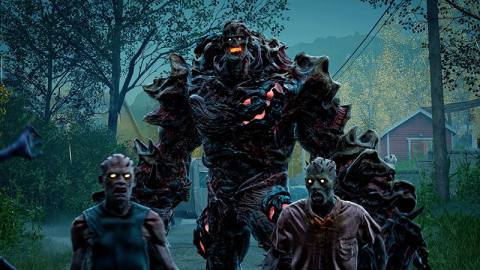
Our first task completed, we lower a bridge that lets us get from one rooftop to another. The noise attracts a horde of Ridden, and we begin fighting off the undead creeps. Thankfully, a doorway on the other roof serves as an effective bottleneck, and one of my teammates who spent their copper lofts on a Molotov cocktail, takes out a considerable fraction of the encroaching enemies. Maybe I should have bought some supplies after all.
Once I get to the second saferoom, I decide to take advantage of the offerings. I have a decent amount of currency to spend, so I refill my rifle ammo and grab a grenade, but I’m eyeing the team support upgrade that gives all healing items extra effectiveness. I don’t have enough copper to purchase it this time, but I decide to scrounge in subsequent stages to give my team that handy upgrade.
The mid-point climax of this campaign occurs as a Ridden the size of a building emerges from the ground. The Ogre enemy type is a powerful, hulking boss that can throw projectiles from a distance or get in close and swipe at you. Our first encounter with the Ogre results in it escaping before we can deplete its health, but it reemerges later in the act to try and finish us off. Thankfully, we’re able to shoot its weak points enough to cause the massive beast to collapse.
While the Left 4 Dead inspiration is evident in nearly every facet of Back 4 Blood, Turtle Rock hasn’t completely thrown out the Evolve playbook. “I think you especially see those influences when you look at the Ogre,” says executive producer Lianne Papp. “We use a lot of those experiences from past titles to help develop that kind of experience and make it an awesome moment because I feel like it’s something you don’t really see in a zombie shooter: something that’s multiple stories tall and towering over you. It adds that extra element of, ‘Oh s—!’”
Though the Ogre serves as a definite highlight of the first campaign, it’s far from the finale. After fighting through a trainyard, we approach a corroded bridge that appears to have been a chokepoint for the survivors to escape. From the looks of it, not many did.
Not only are there zombies galore on this bridge, but also several variants. The Crusher stands close to 15 feet tall and has a giant arm that will squeeze you to death unless you have a stun gun or a teammate who can help. The Hocker is a tiny, agile Ridden who stalks you from afar and spits your way, trapping you in a sticky, spiderweb-like substance. Those two might be among the most dreaded variants to face, but I never enjoyed seeing Reekers waddle my way. Not only can this zombie type vomit acid and inflict corrosive, area-of-effect damage, but some of them explode when you kill them, dealing heavy concussive damage to nearby Cleaners.
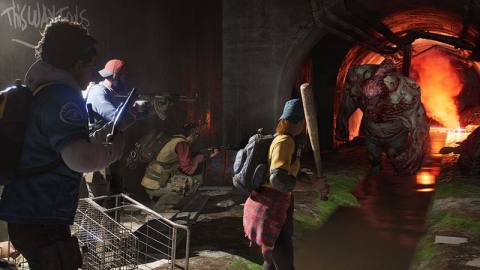
After a mad dash across the bridge, we come to the only thing connecting the Ridden-infested side to the survivor stronghold: a cruise ship. We make it to the other side, but the only way to sever the connection is to plant explosives throughout the boat and blow it up. Unfortunately, the explosives start their countdowns the moment we place them, so efficiency is of the essence. All the activity on the ship has attracted a horde of Ridden, making it even tougher to escape in time, and the results show it. The ship explodes just as our sole surviving teammate leaps from the ledge and lands on solid ground. The rest of the team has perished in the blast, but we count it as a success.
After completing the first campaign, we can tackle Blue Dog Hollow, a new group of missions. This campaign takes place in a more wooded area than the industrial park of The Devil’s Return. Throughout this mission, you encounter farms the zombies turned into nests, a dark tunnel swimming with Ridden, and an abandoned church you must fortify and defend against waves of the undead. However, the Sleeper is the horrifying new highlight of this campaign. These grotesque creatures serve as sentries on the wall. If someone is oblivious enough to walk past, it lunges out at them, delivering one heck of a jump-scare.
The Devil’s Return and Blue Dog Hollow demonstrate just how different the campaigns can be, leaving me hopeful that the rest of the PvE content will continue to deliver distinct twists on the formula Turtle Rock has established. However, for those wanting a different experience escaping the PvE formula, you can also take on other players online through competitive PvP.
Turning The Tables
While the most significant content seems to be in the cooperative campaigns, Back 4 Blood also features a full competitive PvP mode. The competitive mode puts you on opposing sides of the zombie apocalypse; one team of four players controls the human Cleaners, while the other gets to walk among the infected as powerful Ridden variants.
“I think it’s something a lot of people want,” Papp says. “You’re playing a zombie shooter, or you’re playing against monsters of some sort, and then inevitably there are people that go, ‘I want to be the monster. I want to be on the other side.’ It’s giving in to that kind of fantasy and providing people an opportunity to do that.”
After selecting characters and cards, the Cleaners enter a brief scavenge phase where they can explore the map to see what items and weapons they can stock up on before the Ridden descend upon them. Once the timer hits zero, all hell breaks loose, so they had better be prepared.
This mode lets you become the special Ridden types you see in the campaign and turn that feeling of dread into one of delight. Charging toward an isolated survivor as a Crusher and putting the squeeze on them is empowering but playing as the Ridden is most rewarding when coordinating with your teammates. For example, we noticed the Cleaners were hunkering down in a series of closed-in buildings on one map, so we chose Reekers and Exploders with their acid vomit and explosive deaths. As soon as we spawned, we rushed into the rooms and filled them with acid, ending the round swiftly.

Rounds are scored based on how long the Cleaners can survive. Once the Ridden overtake the Cleaners and kill the entire team, the roles reverse, and the zombie players change into Cleaners to see if they can beat the established time. The matches operate on a best-of-three basis, with the hordes thickening and the playable area shrinking the longer the round goes on.
While many players are eagerly looking forward to experiencing the co-op campaigns, Turtle Rock hopes this will serve as a terrific side dish to that main attraction. “[We wanted to] have something that didn’t feel like a major time investment,” Papp says. “A term I’ve stolen from someone else in the industry is ‘snackable.’ I really love our PvP mode because you can just jump in, enjoy it for a little bit, your palms get sweaty, and then you can step back, drink a glass of water, take it easy, and then jump in again. You’re not committing yourself to a multi-hour experience.”
Ready To Feast
While many players have already gotten their hands on Back 4 Blood through various alpha and beta tests, we still have a lot to learn about the game. Turtle Rock Studios certainly thinks the game appeals to the fervent community waiting for a worthy Left 4 Dead successor. We won’t know how much staying power Back 4 Blood has until after its launch, but the foundation is absolutely in place for players to have more fun than should be allowed in the apocalypse.
Back 4 Blood launches on October 12 on PlayStation 5, Xbox Series X/S, PlayStation 4, Xbox One, and PC. Game Pass subscribers will be able to download and play the game on day one.
This article originally appeared in Issue 339 of Game Informer.
